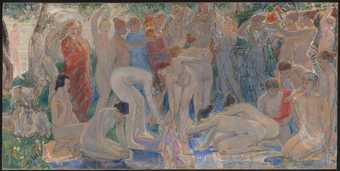University of Bristol
Supervised by Dr Grace Brockington, University of Bristol, and Dr Emma Chambers, Curator Modern British Art, Tate
October 2016 –

Dame Ethel Walker
Decoration: The Excursion of Nausicaa
(1920)
Tate
My doctoral research explores the links between female artists and reform movements in Britain during the early twentieth century. It examines how women worked collectively to create cultural spaces that promoted a feminist worldview in response to social inequalities caused by industrial capitalism and the catastrophic impact of the First World War. The thesis focuses on two vehicles for feminist expression during the period: firstly a growing women-only exhibition culture exemplified by The Women’s International Art Club, which showcased the work of leading artists such as Mary Sargant Florence, Frances Hodgkins, Laura Knight, Ethel Sands and Ethel Walker in its annual shows; and secondly, a pioneering form of symbolist drama which saw innovative producers, designers and dancers including Mabel Dearmer, Edith Craig, Pamela Colman Smith, Margaret Morris and Eleanor Elder work collaboratively across diverse theatre initiatives.
An important context for my discussion is the women’s suffrage movement which struggled for equality in female voting rights during the opening decades of the twentieth century. Many of the artists and organisations I examine can be directly linked to the ‘votes for women’ campaign, however I argue that the aesthetic environments they created outside the remit of suffrage propaganda betray a more far-reaching, utopian desire for social reform than was represented by any one political issue. Similarly, while exhibitions and theatre events in London provide a starting point, they function as nodal markers in my discussion of a more pervasive feminist consciousness, which was informed by women’s interactions at local, national and global levels. As such, the time women spent away from the capital – such as Colman Smith’s childhood in Jamaica, Elder’s travels in India and Hodgkins’ relocation to St Ives during the war – forms an important dimension to my project.
About Katy Norris
Katy Norris is a curator, researcher and writer. She formerly held the position of Curator at Pallant House Gallery where she devised collection displays and temporary exhibitions, including the critically acclaimed exhibitions Sickert in Dieppe and Christopher Wood: Sophisticated Primitive. She is a leading scholar on Walter Sickert and sits on the steering committee for the forthcoming catalogue raisonné on Christopher Wood. She has worked as editor and advisor for the Modern Women Artists book series published by Eiderdown Books and has contributed her research to the British Art Network’s Women Artists Subgroup.
Selected publications:
Sylvia Pankhurst (Eiderdown Books, 2019); Christopher Wood (Lund Humphries, 2016); Sickert in Dieppe (Pallant House Gallery, 2015). Katy Norris has also written for museum catalogues including an essay examining Sickert’s ‘picturesque’ work which accompanied an exhibition of Sickert’s work at Tate in 2022, and an essay entitled ‘Between Men: Masculinity and Fraternity in Stanley Spencer’s Vision of War’ published jointly by the National Trust and Pallant House Gallery in 2013.
Twitter @katysnorris
Instagram @the_decorators_notebook
